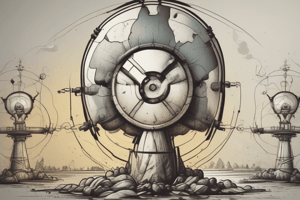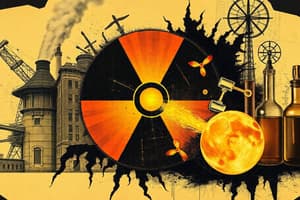Podcast
Questions and Answers
What is produced during positron production in radioactive decay?
What is produced during positron production in radioactive decay?
- A neutron
- A particle with a positive charge (correct)
- A proton
- A photon
How does radioactive decay conserve mass and charge numbers?
How does radioactive decay conserve mass and charge numbers?
- Only the mass number is retained and the charge is altered
- Mass and charge numbers remain constant when comparing reactants and products (correct)
- Charge number is retained but mass number can change
- Both mass and charge numbers are lost during the reaction
What instrument is typically used to measure radioactive decay?
What instrument is typically used to measure radioactive decay?
- Spectrometer
- Mass spectrometer
- Radiation detector
- Geiger-Muller counter (correct)
What is defined as the time required for half of a sample of radioactive nuclides to decay?
What is defined as the time required for half of a sample of radioactive nuclides to decay?
In nuclear transformations, what occurs?
In nuclear transformations, what occurs?
What is the primary role of the weak nuclear force?
What is the primary role of the weak nuclear force?
Which particle is produced during alpha decay?
Which particle is produced during alpha decay?
Which scientist is known for the discovery of polonium and radium while studying uranium?
Which scientist is known for the discovery of polonium and radium while studying uranium?
What is the net effect of beta decay?
What is the net effect of beta decay?
Which of the following statements is true about gamma rays?
Which of the following statements is true about gamma rays?
In what way do alpha particles interact with different materials?
In what way do alpha particles interact with different materials?
Which law must be adhered to when writing a nuclear reaction involving alpha decay?
Which law must be adhered to when writing a nuclear reaction involving alpha decay?
Which of the following statements accurately describes beta particles?
Which of the following statements accurately describes beta particles?
What is the definition of a radioactive decay?
What is the definition of a radioactive decay?
Which term describes atoms with the same atomic number but different mass numbers?
Which term describes atoms with the same atomic number but different mass numbers?
What role does the strong nuclear force play in an atom?
What role does the strong nuclear force play in an atom?
Which of the following is NOT a reason to study nuclear reactions?
Which of the following is NOT a reason to study nuclear reactions?
In a nuclear equation, how is a positron represented?
In a nuclear equation, how is a positron represented?
What is the mass number of an isotope if it has 6 protons and 8 neutrons?
What is the mass number of an isotope if it has 6 protons and 8 neutrons?
Which ionizing particle is produced in carbon-14 decay?
Which ionizing particle is produced in carbon-14 decay?
Which of the following describes a nuclide?
Which of the following describes a nuclide?
Flashcards
Alpha Decay
Alpha Decay
A radioactive decay process where an atom's nucleus emits an alpha particle, which is a helium-4 nucleus.
Gamma Ray
Gamma Ray
A high-energy photon emitted during nuclear reactions. They are very penetrative, requiring lead to block them effectively.
Beta Decay
Beta Decay
A type of radioactive decay where an atom's nucleus emits a beta particle, which is an electron.
Strong Nuclear Force
Strong Nuclear Force
Signup and view all the flashcards
Weak Nuclear Force
Weak Nuclear Force
Signup and view all the flashcards
Radioactive Decay
Radioactive Decay
Signup and view all the flashcards
Radioactivity
Radioactivity
Signup and view all the flashcards
Beta Decay Process
Beta Decay Process
Signup and view all the flashcards
Nucleons
Nucleons
Signup and view all the flashcards
Atomic Number (Z)
Atomic Number (Z)
Signup and view all the flashcards
Mass Number (A)
Mass Number (A)
Signup and view all the flashcards
Isotopes
Isotopes
Signup and view all the flashcards
Nuclide
Nuclide
Signup and view all the flashcards
Radioactive Nucleus
Radioactive Nucleus
Signup and view all the flashcards
Nuclear Equation
Nuclear Equation
Signup and view all the flashcards
Nuclear Forces
Nuclear Forces
Signup and view all the flashcards
Positron Production
Positron Production
Signup and view all the flashcards
Half-life
Half-life
Signup and view all the flashcards
Geiger-Muller Counter
Geiger-Muller Counter
Signup and view all the flashcards
Nuclear Transformation (Transmutation)
Nuclear Transformation (Transmutation)
Signup and view all the flashcards
Conservation of Mass and Charge Number
Conservation of Mass and Charge Number
Signup and view all the flashcards
Study Notes
Radioactivity Objectives
- Learn types of radioactive decay
- Learn how to write nuclear equations for radioactive decay
- Understand how one element can be changed to another by particle bombardment
- Understand the concept of half-life
Review of Atomic Terms
- Nucleons: particles in an atom's nucleus (neutrons and protons)
- Atomic Number (Z): number of protons in the nucleus
- Mass Number (A): sum of protons and neutrons
- Isotopes: atoms with identical atomic numbers but different mass numbers
- Nuclide: each unique atom or the nuclei of a specific isotope
Why Study Nuclear Reactions?
- Central to nuclear energy development
- Used in cancer treatment and medical imaging (PET)
- Used in chemistry to investigate reaction mechanisms
- Used in archaeology to date ancient objects
- Part of military strategies of many nations
Radioactive Decay
- Radioactive nucleus: a nucleus that spontaneously changes and emits energy
- Spontaneous process: occurs by itself with no outside energy required.
- Isotopes undergo radioactive decay naturally, releasing particles and energy.
- This is a random process without outside influence
Radioactive Decay (Continued)
- Radioactivity: the spontaneous decomposition of a nucleus creating a different nucleus and producing one or more particles.
- Nuclear Equation: shows the radioactive decomposition of an element. An example is shown: 14C → 14N + −0e1
- Nuclear Forces: the strong nuclear force holds neutrons and protons together to create a nucleus. It counters electromagnetic repulsion. Weak nuclear force operates within nucleons and produces some types of radioactivity.
Discovery of Radioactivity
- Antoine Henri Becquerel (1852-1908): noticed fogging of photographic plates by uranium crystals
- Pierre Curie (1859-1906) and Marie Curie (1867-1934): further studied uranium and discovered polonium and radium. Marie won two Nobel Prizes but died from radiation exposure.
- Ernest Rutherford (1871-1937): His understanding of atomic structure helped us understand the nucleus. He defined many modern terms for radioactivity.
Alpha Decay
- Alpha particle production (alpha decay): alpha particle = helium-4 nucleus. Blocked by paper, deflected by electric and magnetic fields.
- Net effect: loss of 4 in mass number and loss of 2 in atomic number. Examples shown: 222Ra → 4He + 218Rn and 230Th → 4He + 226 Ra
- Nuclear reactions obey two rules:
- Sum of mass number is the same on both sides of the reaction
- Sum of atomic number is the same on both sides of the reaction
Beta Decay
- Beta-particle production (beta decay): Beta particle = electron.
- Penetrates paper but not aluminum. Deflected oppositely by electric and magnetic fields.
- Less massive than alpha particle. Travels with speed less than 90% of the speed of light. Produced by a decaying free neutron.
- Examples shown: 234Th → 234Pa + −0e−1 and 131I → −0e−1 + 131Xe
- Net effect: neutron changes to a proton.
Gamma Decay
- Gamma ray release (gamma decay): Gamma ray = high energy photon.
- Travels at the speed of light. Can penetrate almost anything but blocked by lead.
- Undeflected by electromagnetic fields. Present in almost all nuclear reactions
- Examples shown: 238U → 42He+234Th+20y
Positron Production
- Positron production: Positron = particle with same mass as an electron but positive charge, an antimatter version of an electron.
- Produced when nuclei has more protons than neutrons
- Example shown: 22Na → 1e + 22Ne
- Net effect: proton changes to a neutron
Conservation of Mass and Charge Number in Nuclear Reactions
- Both mass and charge numbers are conserved in nuclear reactions
- Sum of mass numbers and charge numbers of reactants equal to the sum of mass numbers and the charge numbers of products
Decay Series
- Decay series: the series of radioactive decay from a parent nucleus to a stable daughter nucleus.
- Starts with Uranium-238 (238U) and ends with Lead-206 (206Pb). Each nuclide is radioactive in this series except for 206Pb. Each step shows the successive transformations using arrows.
Nuclear Transformations
- Nuclear transformation or transmutation: forced change of one element to another
- Bombard elements with particles
- Example shown: 14N + 4He → 17O + 1H and 27Al + 42He → 3015P
Practice Problems
- Write and balance the following equation: 13153I → e−1 +...?
- Write and balance the following equation: 5927Co + 1n0 →...?
Detection of Radioactivity
- Geiger-Muller counter: instrument that measures radioactive decay by registering ions and electrons created by a radioactive particle passing through a gas-filled chamber.
Half-Life
- Half-life: time needed for half of the original radioactive sample to decay
- Table shows half-lives for some radium nuclides.
Decay of a Radioactive Element
- Half of the parent radioactive atoms decay after one half-life. Half of the remainder decay after another half-life. The proportion of parent atoms remaining decreases exponentially.
Studying That Suits You
Use AI to generate personalized quizzes and flashcards to suit your learning preferences.




